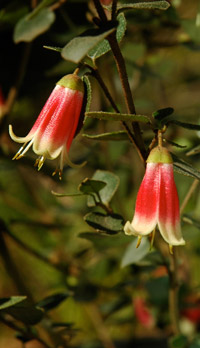Autumn 2012 - Issue 1
Winter 2012 - Issue 2
Spring 2012 - Issue 3
Summer 2012/2013 - Issue 4
Autumn 2013 - Issue 5
Gardens unveils Eucalypt Discovery Walk 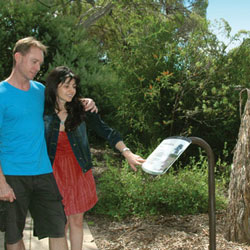
Wind your way through the Gardens and discover 21 of Australia's iconic eucalypts with the new self-guided walk which is supported by interpretation signs and a printed brochure.
Eucalypts are one of the most prominent trees in the Australian
landscape, with over 850 different species. Almost all of them occur naturally only in Australia.
"We have around 500 species growing in the Gardens and we're pleased to be able to give visitors an introduction to their diversity and significance within the Australian landscape. It's also an opportunity to dispel a common misconception that one gum tree is just like another," Dr Judy West, Executive Director of the Gardens said.
The hour-long walk begins by descending into the Tasmanian rainforest where visitors
discover the towering Mountain Ash (Eucalyptus regnans) which is the world's tallest flowering
plant and lives for up to 500 years.
The walk then circles through the heart of the collection – introducing the enigmatic Scribbly
Gum (Eucalyptus rossii) with its beautiful markings made by moth larvae, and the graceful
symmetry of the silver-leafed mountain gum (Eucalyptus pulverulenta), before ending at a
spectacular Flooded Gum (Eucalyptus grandis) in the Rainforest Gully.
"Eucalypts are the most widely planted hardwoods in the world for wood production. They
also provide charcoal, oils, honey, bush medicines and tools, and food and habitat for wildlife.
Come along and discover the world of eucalypts with us this winter," Dr West said.
Development of the walk was a collaboration between the Friends of the Gardens and
Gardens' staff. The project funding was provided by the Bjarne K Dahl Trust, an organisation
committed to advancing the conservation of and education about eucalypts, and the Public
Fund of the Friends of the Gardens.
The interpretive trail was officially opened on 17 May 2013 by Murray Fagg, co-author of the book Eucalypts:
A Celebration, and Honorary Associate of the Gardens.
Blitzing the spectacular Red Centre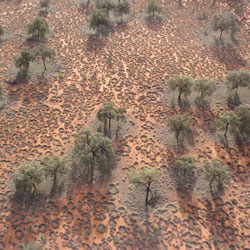
Julie Percival, Gardens horticulturalist, joined of a group of 15 scientists and five teachers on a 12 day expedition to Henbury Station, near Alice Springs, monitoring and collecting new plant and animal species as part of Australia’s largest biodiversity discovery program—Bush Blitz.
Julie's focus was to collect plant material for cultivation and planting in the new Red Centre Garden to be opened at the Gardens this spring. Part of the Gardens’ Living Collections team, Julie has been growing plants for the Red Centre Garden project for the past 2 years.
Working with botanists from the Northern Territory (NT) Herbarium who knew the area and local vegetation, Julie had ready access to fresh seed and cutting material. A few rainy days just before and during the survey assisted in making the trip far more productive for collecting seeds and cuttings than expected.
“I collected opportunistically with the aim of adding iconic and interesting species to the Red Centre Garden,” Julie said.
“I also took the advice of the botanists who kindly pointed out plants that they thought would be of interest to our collection, many with indigenous uses or stories associated. Despite exceeding my baggage limit, I was pleased to bring home 64 collections of mainly seed and some cutting material to grow at the Gardens. Many of these collections may find homes in various sections of the Gardens, not only the Red Centre Garden.”
“A helicopter transported us to areas of the property we would otherwise not have been able to access. This was also very handy for spotting vegetation communities of interest such as a rare Mitchell Grass community.
“Observing arid plants in a variety of natural habitats has deepened my understanding of their growing conditions and vegetation associations which may inform some of our work back in the Gardens nursery and Red Centre Garden,” Julie said.
Bush Blitz is a partnership between the Australian Government, BHP Billiton & Earthwatch.
Henbury Station is a 500 000 hectare property approx 130 kms south of Alice Springs. Henbury extends from the MacDonnell Ranges across the open red plains of the diverse Finke bioregion.
Henbury Station formerly a pastoral property, was purchased in 2011 by R.M.Williams Agricultural Holdings with the support of the Australian Government through its Caring for our Country initiative.
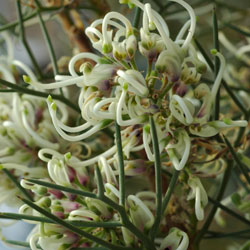
Rare native plant released into the wild after 22 years
A team of translocation experts from the Gardens and NSW Office of Environment and Heritage headed out to the field to boost the population of a rare species, Hakea pulvinifera, known from only one population on a hillside near Lake Keepit.
The joint tranlocation effort is the culmination of 22 years of work with the rare plant by Gardens Nursery Manager, Joe McAuliffe, trialling how to propagate and unlock the secret to the plant’s ability to produce seeds.
"“Hakea pulvinifera is a slow growing root suckering shrub which only grows to about 4 metres high," Joe said. "The native population of the plant is limited to about 150 individuals hanging on to a rocky slope."
Growing in just one site, it was feared a flooding or fire event could wipe the species from the planet.
The traslocation program established two additional small colonies of 110 propagated plants into nearby sites within the Lake Keepit area, so that if something catastrophic happens, the species has a better chance to survive.
“The majority of the plants at the Lake Keepit site are nearing the end of their lives. The few younger plants in the population which are only up to half a metre high are thought to be 100 years old. These plants are thought to be up to 100 years old. The age of the older plants is unknown, but it is thought that they are very old.”
“The Hakea is a very slow growing species that does not produce seed. This, combined with it being difficult to propagate has made building enough numbers for a translocation a slow and tedious process”, Joe said.
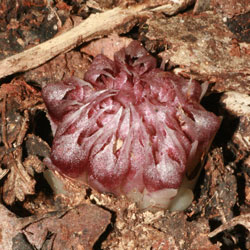 Mammals linked with endangered underground orchid
Mammals linked with endangered underground orchid
Gardens scientist Mark Clements has made an intriguing discovery that two mammals, the Swamp Wallaby and Long-nosed Bandicoot, could dictate where you can find the endangered Eastern Underground Orchid, Rhizanthella slateri.
While researching the biology of rare and endangered orchids threatened by an upgrade of the Pacific Highway in morthern NSW, Mark has observed the mammals eating the seed heads of the underground orchid.
“We are convinced that when the orchid seed head matures it emits a fungal-like smell which attracts these fungus-eating mammals to forage,” Mark said.
“The seeds pass through the animal's gut and are deposited in the dung thereby dispersing the seeds. So distribution of these mammals and the location of the orchid colonies are connected.”
The Eastern Underground Orchid ranges from southeastern Queensland to the south coast of NSW. In NSW, it is currently only known from fewer than 10 locations, including near Bulahdelah. At each location, only a few individuals are known.
Mark has led a team of scientists from the Centre for Australian National Biodiversity Research in studying rare and threatened orchids. Their aim has been to propagate and translocate orchids away from the path of the diverted Pacific Highway to new sites on Alum Mountain, Bulahdelah.
In addition to the Eastern Underground Orchid, they have been researching the Leafless Tongue orchid, Cryptostylis hunteriana, and the Red Helmet orchid, Corybas dowlingii.
“A clear understanding of the biology of these species was necessary, particularly habitat preferences, associated plant species, pollinators and associated mycorrhizal fungi,” Mark said.
“We have undertaken hundreds of hand pollinations, resulting in thousands of seeds being scattered over the sites. Plants that would be destroyed by the construction have been transplanted. Also the orchids are being propagated and grown on at Australian National Botanic Gardens for re-introduction, both now and in the future.”
Work is ongoing, the Orchid Management Plan includes the monitoring of the populations for a minimum of 10 years.
Image caption: The endangered Eastern Underground Orchid, Rhizanthella slateri
Gardens Librarian announced as ACT's Favourite 
Catherine Jordan, the Librarian at the Australian National Botanic Gardens, has been announced as the ACT winner of the Australia's Favourite Librarian competition.
On Library Lovers Day, 14 February 2013, the Australian Library and Information Association (ALIA) set out to find Australia’s Favourite Librarian. They asked Australians to nominate librarians and library workers, with 212 librarians nominated from across Australia. The competition received over 14,000 votes.
Catherine was nominated over ten times, with all of her nominators discussing her extensive knowledge of her specialist library collection and the amazing service she provides for everyone who enters her library. After an online vote Catherine was chosen as the winner from the ACT for its centenary year, with Gardens staff thus dubbing her their "Librarian of the Century".
Catherine enjoys working with the material at the Gardens library. "I love working with diverse material – from the latest scientific journal literature delivered electronically to historic publications from the 1800s containing the first descriptions of newly discovered species, botanical illustrations, maps and the archival collections of our institution which is now more than 40 years old."
On being nominated, Catherine said ‘I am thrilled that a small and specialised library service in a government department has gained this level of recognition. It’s a great opportunity to promote the diversity and value of library services. I am very grateful for the support of the Australian National Botanic Gardens staff and volunteers, and the Friends of the ANBG. And of course it is nice to have one’s efforts acknowledged!’
Catherine holds the title for the ACT and is joined by other winners from each state and territory. The announcement of Australia’s Favourite Librarian kicked off Library and Information Week, 20-26 May 2013.
More information and a list of all the winners can be found at: http://www.alia.org.au/advocacy-and-campaigns/advocacy-campaigns/australias-favourite-librarian-0/australias-favourite-librarian-2013-winners
Image caption: Catherine Jordan with Volume 3 of "The Banksias" by Celia Rosser and Alex George, donated by the Friends of the ANBG in 2001
Turned on walks inspired by Turner’s paintings
Themes from paintings by the famous artist JMW Turner are being featured in free guided walks at the Australian National Botanic Gardens, Saturdays at 11.00 am during the months of June, July and August.
Visitors will be turned on to the colour, light and atmosphere of nature in the Gardens.
Turner‘s art is extraordinary in capturing the colour, light, and atmosphere of nature.
“Turner sometimes painted the same scene at different times to contrast light and colour with dark and shade, in fine weather and foul,” said Ms Glenys Bishop, Convenor of the Gardens' Volunteer Guides.
“In these walks we contrast the colours of the lawns with the shades of the rainforest. The walks also take advantage of various viewpoints in the Gardens to admire the grandeur of nature. They also observe the picturesque design of our rock pool landscapes.”
Turner is also famous for painting seaside scenes and ships, important for national and international travel and exploration. “There are plants collected from the seaside to see, as well as species of Australian trees that were much sought after for ship timber.”
Although Turner never came to Australia, contemporaries of Turner included the explorers Flinders, D’Entrecasteaux and Baudin. These people, as well as the botanists and artists on their voyages, risked danger to not only map parts of Australia but also collect plants in an enthusiastic pursuit of science.
“Some fascinating stories can be told about their contribution to the collection, classification and naming of Australian plants and about the inland explorers, such as Allan Cunningham and Charles Moore” said Glenys.
Special bookings for “Turned On” walks are available upon request for $5 per person. To book a walk, email bookedwalks@friendsanbg.org.au
![Director of National Parks [logo]](../../../images/dnp_90px.gif)





